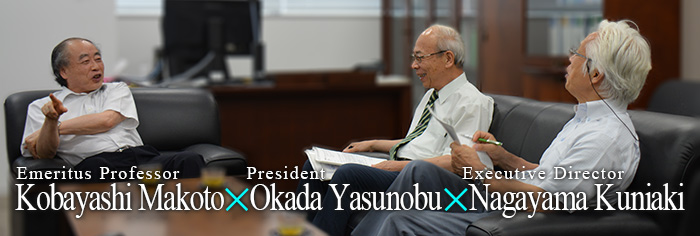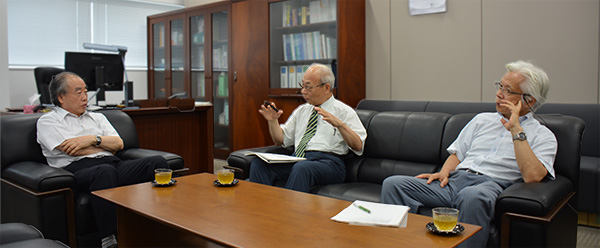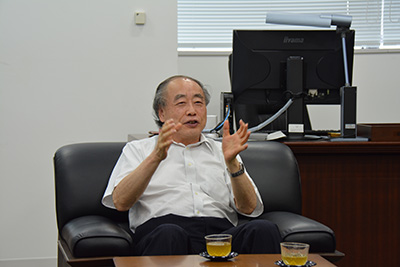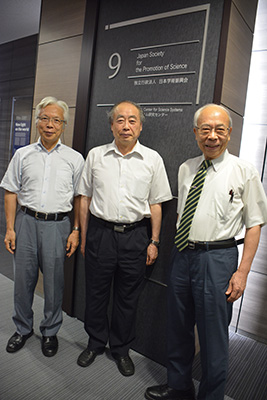[Interview] Emeritus Professor Kobayashi, Makoto No. 2


The Nanbu Theory, as the origin of the Kobayashi, Masukawa Theory, and the large scale KEK facility that could prove the Theory?The use of the accelerator by various research fields and the role of SOKENDAI students.
Nagayama: Personally, for the Nobel Prize to be awarded for Dr. Yoichiro Nanbu's theory felt like it was being given to Japan as a country, for contributing to science by providing the origin of the Kobayashi, Masukawa Theory. How were you affected by the theory?
Kobayashi: The first thing that I studied after I entered university was the Nanbu Theory. I will get a bit technical here, but it was around the time when something called the "Spontaneous Breaking of Chiral Symmetry" was becoming famous. Prior to this, "Current Algebra" had been the trend, and eventually it became clear that what goes on in Current Algebra could be understood by the term "spontaneous breaking." The origin of this theory was the Nanbu Theory, and this is where I began my studies.
In addition, the Renormalization Possibility of the Gauge Theory was proven, which was first generalized in the early 1970s. Incorporating the spontaneous breaking of symmetry concept here greatly advanced the understanding of fundamental particles. Therefore, I think the origin of this development was in the Nanbu Theory. It was around then that we discussed CP-related problems using the theory.
Okada: One of the important actors in the field now is the High Energy Accelerator Research Organization (KEK). It was a crucial achievement for KEK to prove your theory. What are your future expectations for KEK and for students learning at the institute?
Kobayashi: Right now, KEK is about to commit to research in many scientific fields that can utilize the accelerator. Regarding fundamental particles, there are two directions. One is that they are up-scaling the B factory where our theory was proved. They are going to start operating the accelerator from the beginning of next year, and conduct even more precise experiments. They plan to proceed beyond the so-called "Standard Model," and are hoping to gain hints from these precise experiments.
The other direction is the J-PARC (Japan Proton Accelerator Research Complex) experiments, and especially the T2K experiments that utilize the neutrinos generated at J-PARC. The center of attention at the moment is whether the breaking of CP symmetry can be observed in neutrino reactions. They are hoping to solve these questions by continuing experiments on neutrino oscillation. These are currently the two main experimental directions for using the accelerator, but the biggest problem is the operating cost. We were able to complete the construction, but are having difficulty securing the operating budget.
Accelerators are now being used in many other fields besides high-energy experiments. Students from KEK and SOKENDAI are playing a great role as the human resources that are realizing these operations.
Okada: I have one amateur question that I want to take this opportunity to ask. When the Big Bang happened, there were identical numbers of particles and antiparticles, but where are the antiparticles now? When and how do you think this question will be resolved?

Kobayashi: I think your question has to do with cosmology, especially the part that deals with why our universe consists of matter and not antimatter. Regarding whether we can explain this problem using the mechanism we proposed, and that was demonstrated at the B factory, it is impossible at the moment. What I mean is, the mechanism we proposed can explain the CP symmetry violation observed in laboratories, but it is not quite enough to explain issues of the universe.
So then what is effective for solving the problems of the universe? This is where we have great expectations for the CP symmetry violation in the neutrino reactions that I just mentioned. If it exists, there is a great possibility that the question can be explained. That is why everyone is so interested in the neutrino experiments.
The ability to maintain a wide perspective and to look at the bigger picture is essential! The Nobel Prize was awarded for a single paper written when he was in his twenties.
Nagayama: My other question is, was your Nobel Prize awarded for a number of papers, or for a single paper?
Kobayashi: It was for a single paper, which was written in 1972, and published in 1973. I went to Kyoto in April of 1972, and wrote that paper when I was in my twenties, just after having become an assistant professor at Kyoto University.
Okada: What do you think is necessary for young researchers in Japan, including graduate students at SOKENDAI and other institutions, for them to win Nobel Prizes? Any words of encouragement?
Kobayashi: I think the Nobel Prize is a result, but not an end in itself. However, I think that it is ideal to keep your perspective as wide as possible, and to always have the entire picture in mind. It is important to deal with the problem at hand, but I think keeping the overall picture in mind is crucial.
Okada: By this you mean, where your research stands in the bigger picture. In this respect, in the educational reform measures SOKENDAI will take as part of the third term of university reform, we hope to create a system where students first follow a university-wide liberal arts program, then commit themselves to several years of intensive research, and then are finally given the opportunity to grasp the overall picture.
Nagayama: Especially with regard to fundamental particles, Japan is extremely resourceful both in terms of human resources and education. However, do you think that there is any momentum or foundation at SOKENDAI and/or other institutions to produce researchers that will influence the world?
Kobayashi: Looking at the field of fundamental particles, we are at a very difficult phase at the moment, and I think that visible results may not readily appear. There are some experiments we have in mind, but future prospects will be affected by the accelerator, so we cannot be completely optimistic. However, I think the quality of our researchers is comparable to those in the earlier days; there are plenty of excellent researchers. I hope that they are blessed with good results.

Okada: We need to develop an environment that will realize such a future. Dr. Kobayashi, you have an important role in continuing to support Japanese academia through JSPS. We seek your assistance with regard to national universities that have been supporting the nation's strengths.
Kobayashi: Over a hundred active researchers are engaging in heated debates now regarding the overall operations of the JSPS. We are hoping to reflect the current opinions of these researchers to the systems that support research at the universities. We will do our best.
Okada: We are looking forward to that. Dr. Kobayashi, thank you so much for participating in such a lengthy session. We look forward to your continued cooperation and commitment.
p.2/2
Related Content
